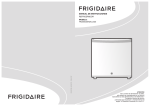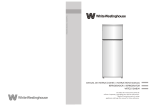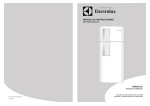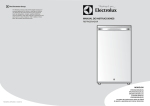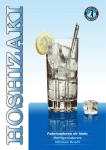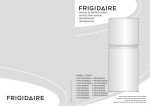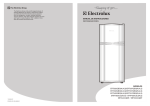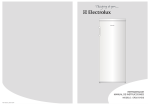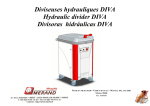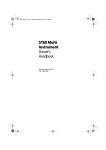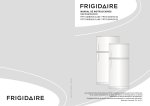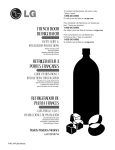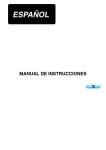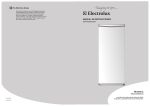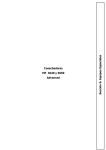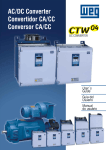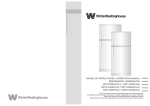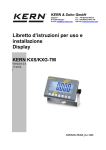Download MANUAL DE INSTRUCCIONES / INSTRUCTIONS MANUAL
Transcript
R0(56,81)WM_BILING_100420P MANUAL DE INSTRUCCIONES / INSTRUCTIONS MANUAL REFRIGERADOR / REFRIGERATOR WRDW125MBJ(W,G) / WRDW123MBJ(W,G) WRDWN123MBJ(W,G) / WRDWN133MBJ(W,G) WRDW133MBJ(W,G) / WRD135UBGW Por favor lea este manual completamente antes de instalar el producto. Lea todas las instrucciones antes de utilizar el aparato y guardelas para futuras referencias. Please read this manual completely before installing the product. Read all instructions prior to using appliance and keep this manual for future reference. Indice Gracias por elegir White-westinghouse como marca para su refrigerador. Los refrigeradores White-westinghouse han sido concebidos bajo altísimos estándares técnicos. Poseen características especiales desarrolladas para ofrecer aun más comodidad al usuario. Para que usted pueda disfrutar todos los recursos que su nuevo refrigerador ofrece, White-westinghouse creó este manual. Con orientaciones simples y prácticas usted conocerá sus funciones y aprenderá la manera de operar este aparato de modo adecuado y seguro. Lea las instrucciones sobre instalación y operación antes de utilizar su refrigerador y guárdelas en un lugar seguro para futuras consultas. Whitewestinghouse una vez más fabrica lo mejor en lo que se refiere a electrodomésticos. Seguridad.....................................................................................................03 Para los niños.........................................................................................03 Para el usuario / instalador.....................................................................03 Eliminación adecuada de su refrigerador/congelador .......................... 05 Antes de deshacerse de su Refrigerador/congelador usado ............... 05 Características del refrigerador ................................................................... 06 Instalación ................................................................................................... 08 Eligir el area ........................................................................................... 08 Nivelación .............................................................................................. 09 Instalación eléctrica ................................................................................ 10 Cable tierra ........................................................................................... 10 Instrucciones de uso ................................................................................... 12 Como prender su refrigerador .............................................................. 12 Abastecimiento ..................................................................................... 12 Como usar el congelador......................................................................... 13 Compartimiento del refrigerador ............................................................ 13 Ajuste de temperatura............................................................................. 14 Descongelamiento.................................................................................. 15 Hacer y retirar cubos de hielo ............................................................... 15 Como desconectar su refrigerador ....................................................... 15 Como ahorrar energía .......................................................................... 16 Transporte ............................................................................................ 16 Sugerencias y consejos ....................................................................... 17 Limpieza y mantenimiento ......................................................................... 18 Parte interna ......................................................................................... 18 Parte eléctrica ....................................................................................... 19 Parte externa ........................................................................................ 19 Burletes de vedado de las puertas ............................................................ 19 Solución de problemas ............................................................................... 20 Condensación en la Superfície Externa ............................................... 20 Vedado de la Puerta ........................................................................... 20 Ruidos Normales de Operación .......................................................... 20 Calentamiento Cercano a las Puertas ................................................. 21 Calentamiento de la Parte Posterior .................................................... 21 Los seguientes casos no son funcionamientos defectuosos............ 21 Antes de llamar al servicio técnico .......................................................... 22 Informaciones técnicas ................................................................................ 47 Consejos ambientales El material del embalaje es reciclable. Procure separar plásticos, espuma flex, papel y cartón y enviarlos a las compañias de reciclaje. Como contribución en la preservación del Medio Ambiente, el gas de refrigeración de este producto es el R134a (Hidrofluorcarbono - HFC), que no afecta la capa de ozono y tiene poco impacto sobre el efecto invernadero. De acuerdo con la directriz de la RAEE (Residuos de Aparatos Eléctricos y Electrónicos), en inglés WEEE (Waste of Electrical and Electronic Equipment), se debe colectar y disponer de los residuos de aparatos eléctricos y electrónicos separadamente. Si futuramente usted necesita desechar este electrodoméstico, NO lo haga echándolo con el resto de la basura doméstica. Sírvase enviar el aparato a los puntos de colecta de RAEE donde los haya disponibles. Atención ESP ESP Bienvenido El aparato que usted ha comprado puede tener un enchufe diferente del que se muestra en las figuras de este manual, siendo que el que viene en el producto cumple la especificación eléctrica de su país. 01 Bienvenido Indice 02 No utilizar artefactos electricos en el interior del compartimiento conservador de alimentos. Los gases del material de aislamiento requieren un procedimiento especial de eliminacion. Por favor, deshagase del material de embalaje de este producto de forma que no resulte nocivo para el medio ambiente. Pongase en contacto con las autoridades locales para deshacerse de este producto de forma segura. Este producto contiene gas aislante inflamable. Porefavor, dashagase del material de embalaje de este producto de forma que no resulte nocivo para el medio ambiente. Para los niños • Evite accidentes. No permita que el refrigerador sea manipulado por niños aunque el mismo se encuentre desconectado. • Destruya la caja de cartón, las bolsas de plástico y cualquier material de empaque exterior inmediatamente después de que el refrigerador sea desempacado. Los niños nunca deben jugar con estos artículos. Las cajas de cartón cubiertas con alfombras, sábanas, láminas de plástico o envoltura de plástico pueden convertirse en cámaras herméticas y causar asfixia rápidamente. • Retire todas las grapas de la caja de cartón. Las grapas pueden causar cortes graves y dañar el acabado si entran en contacto con otros electrodomésticos o muebles. 03 Seguridad • Los refrigeradores o congeladores desechados o abandonados son un atractivo peligroso para los niños, incluso si se dejan abandonados “sólo por algunos días”. Si se va a deshacer de su refrigerador o congelador usado, retire las puertas y deje las bandejas en su lugar de modo que los niños no pueden entrar con facilidad. Para el usuario y instalador • Desenchufe el refrigerador antes de limpiarlo o hacer un trabajo de mantenimiento. •xNo deje el refrigerador sin funcionar durante mucho tiempo. Si necesita hacerlo, límpielo, abra las puertas y déjelo así. Es recomendable que encienda varias veces el refrigerador durante el tiempo que no lo use normalmente. • Lo siguiente no debe ser colocado sobre el refrigerador: objetos inestables o pesados, aparatos que produzcan calor como reguladores. • No vuelva a enchufar el refrigerador hasta 5 minutos despues de haberlo desenchufado para proteger al compresor de la presión excesiva. No instale el refrigerador al aire libre. •xNunca tire del cable para desenchufar el refrigerador, utilice el enchufe. • No apriete, no doble ni ate el cable eléctrico. No altere el enchufe de su refrigerador. Si su cordón de alimentación se daña, este deberá ser reemplazado por un técnico especialista, ya sea del fabricante o del distribuidor. • No almacene medicamentos, productos tóxicos o químicos en su refrigerador. Estos pueden contaminar los alimentos. • Productos en aerosol inflamable, combustible (gas para encendedores, aceite de banana, alcohol, gasolina, propano, etc.) o productos con el símbolo de una llama pequeña, no deben ser almacenados en refrigeradores o congeladores, tampoco se deben acercar al refrigerador, pues pueden provocar explosiones. • Nunca apoye el refrigerador en las puertas, pues esto puede desalinyarlo, permitiendo el escape de aire y baja operación del refrigerador. • Evite el contacto con las paredes del congelador con las manos mojadas o humedecidas. Las temperaturas bajas queden dañar su piel. • No eche agua en la parte superior y los lados del refrigerador, pues puede provocar malfuncionamiento o dañar la parte eléctrica y puede oxidar algunas partes del refrigerador. Para evitar riesgos de incendio, jamás deje velas encendidas sobre el refrigerador. En caso de escape de gas, no desenchufe o toque el refrigerador hasta cerrar la valvula de gas y ventilar la habitación. • Mantega el cable alejado del compresor ya que la temperatura del mismo se eleva durante su funcionamiento pudiendo dañar el aislante del cable y provocar un cortocircuito. • El refrigerador debe ser enchufado en su propio tomacorriente eléctrico individual. El cordón eléctrico del electrodoméstico cuenta con un enchufe de tres clavijas con puesta a tierra para protegerlo de los peligros de choque eléctrico. Debe ser enchufado directamente a un tomacorriente de tres alvéolos debidamente puesto a tierra. No retire ninguna clavija del cordón eléctrico. El tomacorriente debe ser instalado de acuerdo con los códigos y reglamentos locales. Consulte a un electricista calificado. No use un cordón de extensión ni un adaptador. •xSi el voltaje varía en un 10% o más, el rendimiento de su refrigerador puede verse afectado. Si se hace funcionar el refrigerador con energía insuficiente, se puede dañar el compresor. • No haga funcionar el refrigerador en la presencia de vapores explosivos. • Jamás se apoye en la puerta del refrigerador, puede ocurrir el desajuste de las bisagras provocando el escape del frio y consecuentemente el mal ESP ESP Seguridad Seguridad 04 Características del refrigerador Llave de Seguridad Eliminación adecuada de su refrigerador/congelador • Riesgo de atrapamiento de niños. • El atrapamiento y asfixia de niños no son problemas del pasado. Los refrigeradores o congeladores desechados o abandonados todavía son peligrosos, incluso si se dejan abandonados “sólo por algunos días”. Si se va a deshacer de su refrigerador o congelador usado, siga las instrucciones a continuación para ayudar a prevenir accidentes . Antes de deshacerse de su Refrigerador/congelador usado • Retire las puertas. • Deje las bandejas en su lugar de modo que los niños no puedan entrar con facilidad. • Deje las rejillas y los estantes en su lugar así los niños no pueden meterse adentro con facilidad. Llave para cerrar el refrigerador: El atractivo acabamiento de estos refrigeradores compactos incluyen llave para cerrar el refrigerador. El sistema és de manejo fácil y simple. 3 ESP ESP desempeño del refrigerador. 4 2 5 1 6 0 7 8 Llave 1 6 2 3 7 4 5 1 Termostato 5 Patas niveladoras 2 Anaqueles del refrigerador 6 Compartimiento para latas 3 Tapa del crisper 7 Compartimiento de botellas 4 05 Seguridad Características del refrigerador Gaveta para frutas y verduras 06 Instalación 9 ESP 1 2 3 4 5 6 1 Tapa superior 6 Patas Niveladoras 2 Bandeja de goteo 7 3 Anaquel del refrigerador 4 Tapa del crisper 8 Termostato 9 Compartimiento de botellas Congelador 5 Gaveta para frutas y verduras ATENCIÓN: Dadas las constantes mejoras en nuestros productos, su refrigerador puede tener algunas diferencias con respecto a la descripción de este manual, sin embargo, las funciones y métodos de operación continuan siendo los mismos. 07 Características del refrigerador 30cm (parte superior) 10cm (parte posterior) 7,5cm (lateral) 7,5cm ESP 8 7 Eligir el area Elija un lugar que esté cerca de un tomacorriente con conexión a tierra. No utilice un cordón de extensión ni un adaptador. Instale el refrigerador en una area ventilada, lejos de la incidencia directa de rayos solares y distante de fuentes de calor tales como hornos, hornillas o productos inflamables y de areas donde se utilice agua con frecuencia, tales como piletas de lavar. Para un funcionamiento óptimo, instale el refrigerador en un lugar donde la temperatura ambiente no caiga por debajo de los 10°F (-12°C) o exceda los 110°F (43°C). La función Control de congelación está diseñada para mantener automáticamente la temperatura interior seleccionada del refrigerador dentro de estos límites. Para que el calor se disipe rápìdamente y para que el refrigerador trabaje eficientemente consumiendo poca energía se recomienda ubicar el refrigerador observando distancias mínimas de la pared o similar: Parte superior: 30 cm Laterais: 7,5 cm Parte posterior: 10 cm Las paredes exteriores del refrigerador pueden calentarse a medida que el compresor trabaja para transferir el calor del interior. Pueden observarse temperaturas hasta 30°F (17°C) superiores a la temperatura ambiente. Por esta (lateral) Instalación 08 Instalación eléctrica Antes de prender el refrigerador, verifique si el voltaje del tomacorriente en el que el refrigerador se encuentra conectado, es igual al voltaje indicado en la etiqueta localizada próxima del enchufe (en el cable eléctrico) o en la etiqueta de identificación del refrigerador. ESP No instale el refrigerador al aire libre. Nivelación Las cuatro esquinas inferiores del refrigerador deben estar apoyadas firmemente sobre piso estable. El piso debe ser suficientemente fuerte para sostener un refrigerador completamente cargado. Es muy importante que su refrigerador esté nivelado para que funcione correctamente. Si no nivela el refrigerador durante su instalación, la puerta puede quedar mal alineada y no cerrar o sellar adecuadamente, lo que puede causar problemas de enfriamiento, escarcha o humedad. Para nivelar su refrigerador: Después de desechar los tornillos y base de madera de empaque, use un nivel de carpintero para nivelar el refrigerador de adelante hacia atrás. Ajuste los tornillos niveladores de plástico delanteros media burbuja más altos para que la puerta cierre fácilmente cuando se deje abierta a medias. 09 Instalación ESP razón, es particularmente importante dejar suficiente espacio para que circule el aire alrededor del refrigerador, especialmente en climas cálidos. Vigile que el refrigerador no quede apoyado sobre el cable eléctrico. Conecte el refrigerador en un tomacorrientes exclusivo. No utilice alargadores ni conector tipo Triple. Atención No utilice hojas de afeitar ni otros instrumentos afilados que pueden rayar la superficie del electrodoméstico cuando retire las etiquetas adhesivas. Si queda algún residuo de pegamento de la cinta, puede eliminarlo usando una mezcla de agua tibia y detergente suave. También puede tocar el residuo con el lado adhesivo de la cinta que ya haya retirado. No retire la placa de serie. Para su seguridad, solicite a un electricista de confianza que verifique las condiciones de la red eléctrica del area donde será instalado el refrigerador. Los cables del tomacorriente donde será conectado el refrigerador deben ser de cobre y con un mínimo de 2,5 mm2 de largo. Consulte los códigos eléctricos de su pais para mayor seguridad. Cable tierra El cordón de suministro de energía eléctrica tiene un enchufe de conexión a tierra con clavija tripolar para su seguridad personal. Debe ser conectado a un tomacorriente complementario con conexión a tierra, de 3 entradas, conectado a tierra de acuerdo al código de energía eléctrica nacional y a los Instalación 10 códigos y reglamentos locales. ESP No quite el terminal de contacto a tierra, no utilice adaptador para 2 teminales y nunca conecte en el cuadro de informacion técnica. Utilice el cable suministrado con el equipo (no lo cambie). Si el cable tomacorriente presenta algun daño, deberá de ser reemplazado inmediatamente por personal especializado. Para su seguridad, su instalación debe ser prevista de conductor de tierra. De no ser así, realice adecuación con personal especializado. 11 Instalación Atención El aparato que usted ha comprado puede tener un enchufe diferente del que se muestra en las figuras de este manual, siendo que el que viene en el producto cumple la especificación eléctrica de su país. Como prender su refrigerador Conecte el enchufe del refrigerador en el tomacorriente y ajuste el control de temperatura en la posición potencia de congelamiento y refrigeración máxima. Después de cerrar la puerta adecuadamente por algunos minutos, ambos lados del aparato se pondrán tibios. La temperatura externa del refrigerador se elevará levemente hasta finalmente estabilizarse. Después de unos 30 minutos abra la puerta del congelador, podrá sentir entonces el aire frío. Eso significa que la unidad está funcionando adecuadamente. Después de 3 o 4 horas de espacio de tiempo funcionando, el termostato se desconectará y volverá a conectarse automáticamente y dejará los dos compartimientos con la temperatura deseada. Abastecimiento Siga las siguientes instrucciones para el primer abastecimiento o cuando realice el deshielo para limpieza. 01.Permita que el refrigerador funcione por cuatro horas seguidas antes de almacenar los alimentos en su interior. 02.Si los alimentos son frescos, almacénelos a los poco, con intervalos de una hora. 03.Después de abastecer su refrigerador ajuste el termostato en la posición más adecuada, siguiendo las informaciones del item "Ajuste de Temperatura". ESP Instrucciones de uso Instrucciones de uso 12 13 Instrucciones de uso 10.xLos alimentos calientes deben enfriarse a la temperatura ambiente antes de ponerlos en los compartimientos, de lo contrario se elevará la temperatura interna de dichos compartimientos y también el consumo de electricidad del aparato. Ajuste de la Temperatura TERMOSTATO: 1. Ajuste la perilla de control de la temperatura interna del refrigerador de acuerdo a la temperatura del ambiente y su necesidad. 2. La primera vez que prender el refrigerador, el termostato debe estar en la posición “6”. 3. La gama de temperaturas van desde el "1" (poco resfriado) hasta "6" (máximo resfriado). Después de 24 o 48 horas, ajuste el nivel de la temperatura de acuerdo con su n e c e s i d a d . La p o s i c i ó n " 4 " generalmente es la más adecuada para el hogar a la oficina. 3 4 5 2 ESP ESP Como usar el congelador 01. El congelar carnes frescas ayuda a conservar mejor su capacidad nutritiva. 02. Los productos que serán congelados deberán ser frescos y limpios. 03. Envuelva los alimentos en pequeñas porciones, de acuerdo al tamaño de su familia, para que puedan ser consumidos al ser descongelados. Jamás coloque los mismos alimentos por segunda vez. 04. No coloque alimentos calientes en el interior del congelador. Espere hasta que enfríen antes de congelarlos. 05. Porciones pequeñas de alimentos permiten la congelación más rápida y uniforme. 06. Alimentos grasosos tienen un plazo más corto de congelación. La sal reduce el tiempo de almacenamiento de los alimentos. 07. Acondicione los alimentos de modo que estén bien cerrados. 08. Jamás coloque los alimentos que serán congelados en contacto con los alimentos ya congelados pues la temperatura de estos últimos puede aumentar. Compartimiento del refrigerador 01. Para preservar las características de los alimentos y / o líquidos, manténgalos en recipientes cerrados. 02.xEvite colocar alimentos preparados con mucha agua (sopas y caldos) en recipientes sin tapa pues estos pueden congelarse. 03.xAlimentos ricos en agua, tales como el tofu y los vegetales deben almacenarse en la parte inferior frontal del compartimiento refrigerador para que no se congelen. 04.xFrutas y vegetales deben ser lavadas, secadas y embaladas antes de ser depositadas en el refrigerador para su mejor conservación. 05. Al guardar huevos en su compartimiento, cerciorese que son frescos. Guardarlos en posición vertical para mantenerlos frescos por más tiempo. 06. Vegetales en forma de hojas deberán ser guardados en bolsas plásticas en su compartimiento para legumbres / vegetales y frutas. 07. Seque todos los alimentos antes de colocarlos en el refrigerador. 08.xNo apoye alimentos u objetos en la pared interna del fondo del compartimiento del refrigerador. 09.xLos alimentos deben envolverse bien para evitar que se resequen y/o emitan olores. 6 1 Apagado ATENCIÓN No colocar el alimento sobre las salidas de aire; tener cuidado de permitir el suficiente espacio para la circulación de aire apropiada. Instrucciones de uso 14 Descongelar el compartimiento congelador siempre que la capa de hielo en la superficie del evaporador alcance 3 o 4 milímetros. ESP 01. Cuando el refrigerador trabaja por un gran período de tiempo, la superficie interna del compartimiento congelador se cubrirá por una camada de hielo. Esto puedo aumentar el consumo de energía eléctrica y desminuir la refrigeración del aparato. Entonces, debes remover el hielo inmediatamente. 02. Para descongelar el compartimiento congelador desenchufe el aparato, abra la puerta, saque los alimentos e pongálos en un sitio resfriado. Use un raspador plástico o deje que la temperatura suba hasta que el hielo se derrite. Etonces, limpe el hielo y el agua restantes y enchufe nuevamente el aparato. 03.xDespués de descongelar el refrigerador saque el agua de la bandeja de goteo lo más rápido possible. Hacer y retirar cubos de hielo 01. Llene de agua la cubeta de hielo hasta un poco abajo de la línea de graduación y introdúzcala en el congelador. Los cubos de hielo se formarán en aproximadamente 2 a 3 horas. Para hacer hielo más rápidamente coloque el termostato en la posición “MAX”. 02. Tuerza la cubeta levemente con ambas manos en sentidos opuestos para que los cubitos se suelten. No la tuerce de arriba a abajo pues eso podría romperla. Como desconectar su refrigerador 01. Desconecte el cable de alimentación. Saque las charolas para hielo y alimentos. Deje la puerta entreabierta para circulación de aire y para deshumidificación de ambas secciones. 02. Siempre que Ud. desconecte el refrigerador espere por lo menos 10 minutos para volver a prenderlo nuevamente. 03. Si se planea desconectar el Refrigerador por largo tiempo, se deberá desenchufar y en seguida limpiarlo cuidadosamente. Asegúrese de dejar la puerta del aparato entreabierta y de dejarlo en un lugar ventilado para evitar malos olores. 15 Instrucciones de uso Como ahorrar energía 01. Instale el refrigerador en el lugar más frio de la habitación, fuera del alcance de los rayos de sol y aparatos que desprendan calor. 02. La puerta del refrigerador debe permanecer abierta solamente el tiempo necesario y no coloque alimentos calientes en su interior. 03. Organize el refrigerador de manera que se diminuya la cantidad de veces que tenga que abrir la puerta. 04. La puerta de su refrigerador debe estar siempre bien cerrada para evitar el aumento en el consumo de energía, la formación excesiva de hielo y /o la condensacion interna. 05. El aire frío en constante circulación mantiene la temperatura homogénea en el interior de su refrigerador. Por esta razón es importante distribuir bien los alimentos para facilitar la distribución de aire frío entre los mismos. 06. Cubra los alimentos y seque los contenedores antes de ponerlos en el refrigerador. 07. No llene demasiado ni tape las salidas de aire del refrigerador. No cubra con papel aluminio, ni otro material las parrillas pues interfere con la circulación del aire frío. 08. No cuelgue ropas, paños u objetos sobre el condensador, ubicado en la parte posterior de su refrigerador. Eso afecta su funcionamiento, provoca desgaste en el compresor (motor) y aumenta el consumo de energía. 09. Durante ausencia prolongada (ejemplo: vacaciones) se recomienda desconectar el refrigerador, retirar todos los alimentos y limpiarlo. La puerta deberá mantenerse entre-abierta para evitar el moho y olores desagradables. Esto no comprometerá su funcionamiento al ser reconectado. 10. Durante ausencias cortas (ej.: feriados), su refrigerador podrá permanecer prendido. Pero recuerde que durante su ausencia podrá ocurrir el corte de luz prolongado. ESP Descongelamiento Transporte Para transportar su refrigerador, no lo incline para el lado derecho de quien lo mira de frente. Para distancias cortas, inclínelo para tras o para uno de sus lados, en angulo de 30º como máximo. Para distancias largas, como cambio de residencia, manténgalo en posición vertical. No aplicar fuerza en cualquier parte, tal como el condensador y la puerta para evitar que el refrigerador se deforme, esto podrá influenciar en su funcionamiento. Instrucciones de uso 16 ESP Substitución del foco 1. Antes de cambiar el foco desenchufe el refrigerador. 2. Quite los tornillos usando un desarmador estrella. 3. Quite la cubierta de la bombilla tirándola suavemente hacia abajo. 4. Desenrosque la bombilla. 5. Coloque una nueva bombilla para refrigerador de 10W del mismo tipo y tamaño. 6. Vuelva a colocar la cubierta de la bombilla y los tornillos. Sugerencias y consejos 01.Evite el contacto de todo tipo de grasas con las partes plásticas del refrigerador. Bajo ninguna circunstancia lubrique su refrigerador. 02.Botellas de vidrio, plástico y envases metálicos cerrados no deben ser colocados en el compartimiento del congelador, a menos que esté recomendado por el fabricante en el embalaje del producto. 03.Alimentos o líquidos no deben ser almacenados en recipientes abiertos en el refrigerador. Líquidos efervescentes no deben ser congelados. 04.Para congelar alimentos frescos, utilice el compartimiento superior (congelador). Acondicione los alimentos adecuadamente antes de congelarlos. Evite almacenar alimentos frescos sobre o al lado de los que ya están congelados. 05.Si le ocurre cualquier problema a su refrigerador, transfiera todos los alimentos a otro aparato. 06.No es aconsejable poner objetos demasiado pesados, puntiagudos o corrosivos sobre el refrigerador. 07.Abra las puertas de su refrigerador lo menos posible cuando falte electricidad. 08.No toque los alimentos o envases que están en el interior del refrigerador con las manos mojadas para evitar que se congelen. 09.No almacene alimentos embotellados o enlatados ya que el volumen de los mismos se expande cuando se congelan, pudiendo provocar que el recipiente se quiebre. 10.No abarrote el refrigerador con muchos alimentos ya que podrían obstruir la circulación de aire y aumentar el consumo de energía. 11.Use recipientes herméticos y bolsas plásticas para evitar que los alimentos pierdan humedad y que los olores se mezclen. 12.Limpie los alimentos, botellas y envases antes de almacenarlos en el refrigerador. Si es necesario seque el agua. 13.No coloque alimentos en el sensor de temperatura ni en la pared posterior interna del refrigerador. 17 Instrucciones de uso Desenchufe el refrigerador antes de empezar a limpiar. Nunca limpie su refrigerador con fluidos inflamables como alcohol, querosén, gasolina, thinner, solventes o productos químicos / abrasivos como detergentes, ácidos, vinagre. Tampoco use productos de limpieza tales como detergentes en polvo, detergentes abrasivos, limpiadores alcalinos, paños químicos, solventes, alcohol ni agua caliente para limpiar el refrigerdor pues podrían dañar la pintura y las partes plásticas. Si no va a utilizar el refrigerador por largo tiempo, retire todos los alimentos, desenchúfelo, límpielo y seque su interior, luego ciérrelo bien. No limpie el refrigerador echandole directamente agua ni a la parte interna ni a la parte externa. ESP Limpieza y mantenimiento Parte interna Antes de empezar la limpieza, recuerde que objetos húmedos se adhieren fácilmente a superficies extremadamente frías. Por eso, no toque estas superficies con paños, objetos o manos húmedo. Limpie el interior del refrigerador con un paño humedecido en una solución de agua tibia y bicarbonato de sodio (una cuchara de sopa de bicarbonato para cada litro de agua). Nunca utilice objetos metálicos, cepillos, productos abrasivos o alcalinos para limpiar las superficies plásticas en el interior de su refrigerador. Limpieza y mantenimiento 18 Las piezas plásticas no deben ser lavadas con agua caliente. ESP Parte eléctrica Use un paño seco para limpiar las partes eléctricas y evitar cortocircuitos. Parte externa Limpie la parte externa con un paño humedecido en agua tibia y jabón neutro. Cada 6 meses realice la limpieza de la parte posterior del refrigerador con la aspiradora o un plumero. La tierra acumulada allí interfiere en el perfecto funcionamiento del condensador y consecuentemente el desempeño del refrigerador, ocasionando más consumo de energía eléctrica. Desconecte el refrigerador antes de iniciar la limpieza y cuide de no tocar el condensador ni el compresor. Estos pueden estar calientes. Se deberá limpiar la bandeja de drenaje por lo menos una vez al año. Habrá fugas de agua dentro de su refrigerador si el tubo de desagüe está obstruido, en ese caso, desmonte la mascarilla protectora del foco y lave dicho tubo de desagüe. Burletes de vedado de las puertas El burlete de la puerta deberá ser limpiado cuidadosamente con un paño húmedo. Enjuáguelo y séquelo con cuidado para no dañarlo. 19 Limpieza y mantenimiento Piezas removibles del interior y exterior Lave las piezas removibles con un detergente suave y agua tibia. Séquelas. No utilice limpiadores abrasivos sobre estas superficies. Limpieza de la bandeja de agua La bandeja del agua se ubica en la parte trasera del Refrigerador. Su función es recoger y evaporar el agua proveniente del descongelamiento. Normalmente no necesitan de cuidados especiales, sin embargo, en el caso de haber desbordamientos u olores raros, será necesario verificarlos y limpiar el aparato. Primeramente, desenchúfelo. Levante un poco la bandeja de agua y inclínela retirando el agua cuidadosamente. (Cuidado: asegúrese de que el tubo de desagüe no esté demasiado caliente). Después de terminar la limpieza, vuelva a colocar la bandeja de agua en su posición original. Asegúrese de que la manguera esté sobre la bandeja de agua antes de volver a encajarla. Se deberá limpiar la bandeja de drenaje por lo menos una vez al año. Atención Después de haber limpiado el refrigerador verifique lo siguiente: 01. Revise que el cable de energía no esté roto. 02. Revise que el enchufe esté bien conectado al tomacorriente. 03. Revise que el cable a tierra esté instalado. Condensación en la superfície externa Según la norma internacional ISO8187, los refrigeradores, congeladores y combinados de uso doméstico no deben presentar condensacion en la parte externa. Sin embargo cuando instalados en areas con humedad relativa superior a 80% y temperatura ambiente superior a 32ºC es normal que el refrigerador presente condensación externa (sudor). ESP Solución de problemas Vedado de la puerta Al cerrar la(s) puerta(s) se formará un vacio interno. Este vacio dificultará su inmediata apertura. Recomendamos aguardar algunos instantes para reabrirla(s). Ruidos normales de operación Al prender y apagar su refrigerador podrá presentar un estallo que es perfectamente normal. Es el funcionamiento del termostato (control de la temperatura). Durante su funcionamiento el refrigerador podrá producir un 'chillido', especialmente con la puerta abierta. Este ruido se debe a la expansión del fluido refrigerante dentro del evaporador. No es un problema en el aparato. Debido al sistema de vedado de la puerta, pueden ocurrir ruidos y estallidos al cerrarla. Esto es el resultado del súbito enfriamiento del aire interno. El compresor podrá generar un ruido o Solución de problemas 20 Calentamiento cercano a las puertas Es normal que esta área, cercana a la puerta y laterales presenten temperaturas elevadas. El calentamiento evita la formación de humedad. Calentamiento de la parte posterior Es normal que esta area presente temperatura elevada pues allí circula el fluido refrigerante en alta temperatura. Evite el contacto con esta parte del refrigerador. Antes de llamar al servicio técnico: Rrevise los siguientes puntos Agua/humedad/escarcha dentro del refrigerador Si el ambiente es húmedo y caluroso. Es posible que la puerta no selle correctamente. La puerta se mantiene abierta demasiado tiempo o se abre con demasiada frecuencia. Hay alguna comida que puede estar chorreando? ESP ESP un sonido parecido a pulsaciones. Es una característica de los compresores modernos que funcionan a velocidades más altas que los antiguos. La contracción y dilatación de los componentes internos, debido a la variación de temperatura, pueden generar pequeños estallidos en su refrigerador. Sonidos y ruidos El refrigerador está desnivelado. Se balancea en el piso cuando se mueve levemente. El refrigerador está haciendo contacto con la pared. Los refrigeradores modernos han aumentado la capacidad de almacenamiento y la estabilidad de las temperaturas. Requieren un compresor de alta eficiencia. El refrigerador funciona a presiones mayores durante el inicio del ciclo de ENCENDIDO. El refrigerante (usado para enfriar el refrigerador) circula a través del sistema. Las piezas de metal se expanden y contraen al igual que en las tuberías de agua caliente. Los alimentos están tapando las salidas de aire. Alimentos calientes o demasiados alimentos en el refrigerador. El control de temperatura no está ajustado correctamente. Condensación dentro del refrigerador Los siguientes casos no son funcionamientos defectuosos 01.Toma algunos momentos hasta que las temperaturas de los compartimientos congelador y refrigerador se pongan frías cuando la unidad está en marcha: Si la temperatura de los dos compartimientos es más alta, cuando la unidad está funcionando, tomará algunos momentos hasta que baje. 02.La superficie del compresor se calienta: Es normal que la superficie del compresor se caliente cuando este está funcionando adecuadamente. Usted no debe tocarlo. 21 Solución de problemas La temperatura ambiente es alta o la puerta se dejó abierta por mucho tiempo. Líquidos dentro del refrigerador no están cerrados correctamente. El refrigerador no funciona o no esfria suficiente La puerta no está cerrada correctamente. El empaque de la puerta está dañado. El refrigerador no está bien ventilado. No hay suficiente espacio alrededor del refrigerador lateral y superior. Solución de problemas 22 Las puertas se abren con demasiada frecuencia o por demasiado tiempo. La puerta del refrigerador puede estar levemente abierta o se abrió con frecuencia. El control de la temperatura está en un ajuste demasiado bajo. Chasquidos El control de frío se enciende y apaga continuamente. ESP ESP El refrigerador recibe rayos de sol o está cerca de una fuente de calor. Es posible que el refrigerador no esté enchufado o que el enchufe esté flojo. La junta del refrigerador está rota o doblada. El control de la temperatura está en la posición "OFF" (apagado) o baja. El refrigerador fué desconectado por um período largo recientemente. Gran cantidad de alimentos calientes fué almacenado recientemente. Se quemó un fusible de la casa o se disparó el disyuntor. El refrigerador está enchufado a un circuito de interruptor de falla de conexión a tierra. Interrupción de la energía eléctrica. Problema de la puerta El refrigerador está desnivelado. Se balancea en el piso cuando se mueve levemente. La temperatura interna del refrigerador es demasiado tibia La bombilla no enciende (algunos modelos) El control de la temperatura está en un ajuste demasiado tíbio. La puerta se mantiene abierta demasiado tiempo o se abre con demasiada frecuencia. Es posible que la puerta no selle correctamente. Se almacenaron grandes cantidades de alimentos tibios o calientes recientemente. El refrigerador fue desconectado recientemente por un período de tiempo. Se quemó la bombilla. No llega corriente eléctrica al refrigerador. Atención Sí las medidas susodichas no solucionan el problema, por favor entre en contacto con un centro de servicios de mantenimiento lo más pronto posible. Alimentos almacenados en el refrigerador se están congelando La tempertura del refrigerador está ajustada para la mínima? La temperatura ambiente es inferior a 5ºC? El alimento está cerca de la salida de aire frio? Olores en el refrigerador El interior debe ser limpiado. Hay alimentos con olores fuertes en el refrigerador. El refrigerador funciona demasiado o por demasiado tiempo. La temperatura de la habitación o del ambiente es caliente. El refrigerador fue desconectado recientemente por un período de tiempo. Se almacenaron grandes cantidades de alimentos tibios o calientes. 23 Solución de problemas Solución de problemas 24 Contents Thank you for choosing White-westinghouse. This manual contains all the information you will need to safely and correctly use your refrigerator. Please read all the instructions prior to using the appliance, and keep this manual in a secure place for future reference. Do not remove the attached adhesive identification label containing code, model number, manufacturer and other information from the refrigerator. This label will be used by the Whitewestinghouse authorized service representative in the event that your refrigerator needs servicing. Safety ............................................................................................................... 27 For Children ................................................................................................. 27 For the User / Installer .................................................................................. 27 Proper Disposal of your Refrigerator ........................................................... 28 Before you Throw Away your Old Refrigerator .............................................. 28 Referigerator description................................................................................... 29 Refrigerator Parts ........................................................................................ 29 Installation ........................................................................................................ 31 Choosing the Location ................................................................................. 31 Leveling the Refrigerator ............................................................................. 32 Electrical Installation ................................................................................... 32 Grounding .................................................................................................. 33 Usage Instructions ............................................................................................ 34 How to Turn on the Refrigerator ................................................................ 34 Filling the Refrigerator ................................................................................ 34 How to use the chilled room ........................................................................ 35 Refrigerator Compartment ......................................................................... 35 Adjust temperature ..................................................................................... 36 Defrosting .................................................................................................. 37 Making and removing ice cubes ..................................................................37 How to Disconnect the Refrigerator .......................................................... 37 How to Save Energy ................................................................................. 38 Transportation ........................................................................................... 38 Hints and Suggestions .............................................................................. 39 Cleaning and Maintenance ............................................................................... 40 Inside ........................................................................................................ 40 Electrical Parts ...........................................................................................40 Outside ...................................................................................................... 41 Door Seals ................................................................................................ 41 Solution the Problems ....................................................................................... 42 Condensation Outside the Refrigerator .................................................... 42 Door Seals ................................................................................................ 42 Normal Operating Noises ......................................................................... 42 Warmth Near the Doors ............................................................................ 43 Warmth Near the Back ............................................................................. 43 Normal Operation ..................................................................................... 43 Before Calling Your Service Representative ................................................. 44 Technical Information ....................................................................................... 47 Environmental Advice The packaging material used is recyclable; we recommend that you separate plastic, paper and cardboard and give them to recycling companies. To help preserve the environment, the refrigerant used in this product is R134a (Hydrofluorocarbon - HFC), which does not affect the ozone layer and has little impact on the greenhouse effect. According to WEEE (Waste of Electrical and Electronic Equipment) guidelines, waste from electrical and electronic devices should be collected separately. If you need to dispose of this appliance in the future, do NOT throw it away with the rest of your domestic garbage. Instead, please take the appliance to the nearest WEEE collection point, where available. Attention The refrigerator you have just purchased may be slightly different from the one shown in the drawings in this manual, but its overall design is the same. Please read the information referring to its operation.This refrigerator is intended for domestic use only. The plug on the refrigerator you have purchased may be different from the one shown in the manual, as the plug that accompanies the product meets your country's electrical specifications. 25 Welcome ENG ENG Welcome Contents 26 Do not use electronic appliances inside the refrigerator/freezer compartment. The gases used as isolator require a special procedure to get rid of. Please, throw the packing material of this product in the way that doesn't affect the ambient. Please, contact a local authorities to get rid of this product in a safety way. This product contains inflammable isolator gas. For children • Avoid accidents. After unpacking the refrigerator, keep packaging materials out of reach, especially from children. Do not allow children to handle the refrigerator, even when it is disconnected. • Destroy carton, plastic bags, and any exterior wrapping material immediately after the refrigerator is unpacked. Children should never use these items to play. Cartons covered with rugs, bedspreads, plastic sheets or stretch wrap may become airtight chambers, and can quickly cause suffocation. • Remove all staples from the carton. Staples can cause severe cuts, and destroy finishes if they come in contact with other appliances or furniture. • An empty, discarded ice box, refrigerator, or freezer is a very dangerous attraction to children. For the user / installer • Disconnect the refrigerator before 27 Safety cleaning or doing maintenance. • Do not leave the refrigerator unused for long periods of time. If this becomes necessary, clean it, open the doors, and leave them open. We recommend that the refrigerator be turned on several times during the period it is not in normal use. Do not install the refrigerator outside. • The following items should not be place on top of the refrigerator: heavy and unstable objects, and heat-producing devices like regulators. • Wait at least 5 minutes after unplugging the refrigerator before plugging it in again to protect the compressor from excessive pressure. • Never unplug the refrigerator by pulling on the power cord. Use the plug. •xDo not compress, fold or tie up the power cord. Do not change your refrigerator's plug. If the cord becomes damaged, it must be replaced by a service technician indicated by the manufacturer or distributor. • Do not store medication, toxic or chemical products in the refrigerator, as they may contaminate the food. • Flammable aerosols and combustible products (gas for lighters, banana oil, alcohol, gasoline, propane, etc.) or products that bear a small flame symbol should not be stored in refrigerators or freezers, nor come close to the refrigerator, as they may cause explosions. • Never lean on the refrigerator door, as this may cause the hinges to become misaligned, allowing the cold air to escape and the refrigerator to operate poorly. • Avoid contact with the cold plate / internal walls of the freezer compartment when your hands are wet or damp. The low temperatures may injure your skin. • Do not sprinkle water on top or along the sides of the refrigerator, as this can cause a malfunction or electric discharge and may cause the metallic parts of the refrigerator to rust. To avoid the risk of fire, never place lit candles on top of the refrigerator. In the event of a gas leak, do not unplug or touch the refrigerator until the gas valve has been closed, and the room has been aired out. If you use the thermostat immediately afterward, it may give off sparks that could start a fire. • Keep the cord away from the compressor, as the compressor heats up when it is operating, and may damage the cord, which could cause a short circuit. • The refrigerator should be plug in its own outlet. The power cord has a three-pronged grounded plug for your personal safety. It must be connected to a grounding type wall receptacle, in accordance with the legislation governing electric installations in your country, as well as any local regulations. Do not remove the grounding prong, do not use a two pronged adaptor, and never make a conection to the schematic. Use the cord supplied with the equipment (do not change it). If the cord is damaged, it must be immediately replaced by specialized personnel. • The performance of you refrigerator might be effected if the voltage vary more than 10%. If the refrigerator works below the minimum required might damage the compresor. ENG ENG Safety Proper disposal of your refrigerator • Risk of child entrapment. • Child entrapment and suffocation are not problems of the past. Junked or abandoned sit for "just a few days." If you are getting rid of your old refrigerator , please follow the instructions below to help prevent accidents. Before you throw away your old refrigerator: • Remove doors. • Leave shelves inplace so children maynot easily climb inside. Remove the door(s) of any appliance that is not in use, even if it is being discarded. Safety 28 Refrigerator parts Refrigerator Parts 8 ENG 7 9 1 ENG Key Lock to close the refrigerator: The attractive finish of these compact refrigerators includes Key lock. This system is easy and very simple to use. 2 3 Llave 4 5 1 6 6 2 3 7 4 5 1 Thermostat knob 5 Leveling legs 2 Refrigerator shelves 6 Can Pocket 3 Vegetable drawer 7 Bottle Pocket 4 Vegetable box 29 Refrigerator parts 1 Superior cover 6 Leveling legs 2 Drip Tray 7 3 Shelf 4 Vegetable drawer 8 Thermostat 9 Bottle Pocket Freezer 5 Vegetable box NOTE: Since we are constantly working to improve our products, your refrigerator may be slightly different from the description contained in this manual, however, the functions and operation of the procedure remain the same. Refrigerator parts 30 Choosing the location Place the refrigerator close to a grounded outlet. Do not use any adaptor or extension. Install the refrigerator in a wellventilated area, away from direct sunlight and from heat sources, such as ovens and burners, from inflammable materials, and from areas where water is frequently used, such as sinks. For a better performance, install the refrigerator in a room with temperature between 10ºF to 110ºF. The freezer was designed to keep it intern temperature between this range. In order to ensure that heat dissipates rapidly and that the refrigerator operates efficiently, with low energy consumption, we recommend leaving the following minimum distances between the refrigerator and the walls and ceiling: Top: 30cm Sides: 7,5cm Back: 10cm Check to be sure that there is enough space in front of the refrigerator to open the door (160°). The exterior walls can warm up due to the compressor and transfer the temperature inside. So you can feel temperature 30ºF higher than the room temperature. For this reason it is important to keep enough space around the refrigerator to allow air circulation. 31 Installation 30cm (top) 10cm (back) 7,5cm (side) 7,5cm (side) Do not install the refrigerator outdoors. Leveling the refrigerator Install the refrigerator on a completely level and solid surface. The door must be closed when leveling the refrigerator Use a level with glass-enclosed bubble to verify whether the refrigerator is properly leveled, with the four feet firmly on the floor. If the refrigerator needs to be adjusted, carefully lean it and turn the front adjustable leveling feet until it is firmly installed. Proper leveling prevents movement, vibration and other problems. Do not substitute the original refrigerator feet. Wait at least 2 hours before plugging the refrigerator in this will prevent operating problems. To Level Your Refrigerator: After discarding crating screws and wood base, use a carpenter’s level to level the refrigerator from front-toback. Adjust the plastic leveling feet in front, ½ bubble higher, so that the door closes easily when left halfway open. ENG ENG Installation Electrical installation Before turning on the refrigerator, check to see if the voltage of the outlet to be used is the same as that indicated on the tag located close to the plug (along the power cord) or on the refrigerator's identification label. Installation 32 Check to see that the refrigerator’s plug is not connected on top of the power cord. Connect the refrigerator to its own outlet. Do not use an extension cord or adaptor plug. For your safety, ask an electrician to verify the condition of the electric wiring in the area where the refrigerator will be installed. The wires leading to the outlet into which the refrigerator will be plugged should be made of copper and be at least 2.5 mm2 wide. For greater safety, consult the legislation on electrical installations in your country. How to turn on the refrigerator 01. Clean the parts of the refrigerator with warm water containing a little neutral detergent and with clear water,and wipe them dry. 02. Turn the thermostat knob to the "MAX" position, turn on electricity. The compressor and the light inside the refrigerator begin to work.. 03.iiOpen the door 30 minutes later, if the temperature in the refrigerator decreased obviously, it shows that the refrigerator system works well. When the refrigerator operates for a period of time, the temperature controller will automatically set the temperature within limits it opens. Electric parts of the refrigerator can only be wiped by dry cloth. Note: Turning the temperature control to OFF turns off the compressor, but does not disconnect the power to the light bulb or other electrical components. Grounding The power cord has a three-pronged grounded plug for your personal safety. It must be connected to a grounding type wall receptacle, in accordance with the legislation governing electric installations in your country, as well as any local regulations. Do not remove the grounding prong, do not use a two pronged adaptor, and never make a connection to the schematic. Use the cord supplied with the equipment (do not change it). If the cord is damaged, it must be immediately replaced by specialized personnel. 33 Usage instructions Attention For your safety, installation must be grounded. If it is not grounded, it must be adapted for this by specialized personnel. ENG ENG Usage instructions Filling the refrigerator Follow these instructions the first time you fill the refrigerator, or after you defrost it. 01. Turn the refrigerator on and let it run for two hours prior to putting food inside. 02.xIf the food is fresh, put it in the refrigerator little by little, in one hour intervals. 03.iAfter filling the refrigerator, adjust the thermostat to the appropriate position, following the instructions under item "Temperature Adjustment". Usage instructions 34 01. To freeze fresh meat helps to keep better its nutrients. ENG 02. Put fresh and clean food such like fish,meat into ice room ,therefore the taste and nutrient of food are preserved. 03.xWrap food to be frozen in ALUMINIUM FOIL or place it in AIRTIGHT boxes. 04. Do not put warm foods in the freezer. Wait until they are cold or in room temperature. 05. Small portions allow fast and uniform freezing. 06. Greasy foods have short freezing time. Salt reduce storage time of foods. 07. If you buy deep frozen food in the shops,bring it home and place it in ice room as quickly as possible so that the time during which it kept in the air temperature is as SHORT AS POSSIBLE. 08. Do not allow already frozen food into direct contact with food to be frozen. Refrigerator compartment 01. To maintain the characteristics of food and/or liquids, keep them in closed containers. 02.xAvoid placing foods prepared with a large amount of water (soups and broths) in containers without lids, as they may freeze. 03.xFoods with high water content, such as tofu and vegetables, should be stored in the lower front part of the refrigerator to keep them from freezing. 04. To keep fruits and vegetables fresh longer, they should be washed, dried and packed before being placed in the refrigerator. 05.xWhen keeping eggs in the egg compartment, check that they are fresh. Keep them in a vertical position to remain fresh longer. 06. Leafy greens should be kept in plastic bags in the vegetable and fruit bin. 07. Dry all foods before placing them in the refrigerator. 08. Do not lean food or objects against the internal back wall of the refrigerator. 09. Food should be well wrapped to keep it from drying out or giving off odors. 35 Usage instructions 10. Hot foods should be cooled to room temperature before being placed in the compartments; otherwise they will raise the internal temperature of the compartments, as well as the appliance's energy consumption. Temperature adjustment 01. The temperature in the refrigerator compartment and freezer compartment is controlled by the temperature controller installed on the side wall of the refrigerator compartment. 02. Turn the thermostat knob from right to left, so you can regulate the temperature inside the refrigerator. 03. For the first time of use, please set the temperature in the position 6 for 24 hours. After 24 hours, please set the temperature as you need. 04. The marks on the knob are the temperature grades, not the exact number of the degrees of temperature. "Off" shows a forced STOP and "6" shows the lowest temperature. Turn the knob from "1" position to "6" position, the temperature decreases continuously. You may set the temperature control selector to any position according to what you need. 05. Please set the selector to "3" position in normal use. ENG How to use the chilled room 4 3 5 2 6 1 Off Attention Do not place food over the air vents. Be careful to allow sufficient space for proper air circulation. Usage instructions 36 How to save energy Always defrost the freezer compartment when ice reach 3 to 4 milimeter high. 01. Install the refrigerator in the coolest part of the room, out of direct sunlight and away from heating ducts or registers. Do not place the refrigerator next to heat- producing appliances such as a range, oven or dishwasher. 01. When the refrigerator working for a period of time ,the inner surface of the chilled room will be covered with a layer of white frost.It may raise the electricity consumption and lessen the effect of refrigeration.Then you should do frost removement at once. 02. When defrosting,cut off the power ,open the door and move frozen foods to a shady and cooling place,defrost with a plastic scraper,or let the temperature rise naturally till frost melts.Then wipe away remaining ice and water,and switch on electricity again. 03. After defrosting ,clear away defrosting water in water pan as soon as possible. Attention Do not use sharp metal tools because it could damage the refrigerator. Making and removing ice cubes Fill the ice tray with water to just below the line and place it in the evaporator. The ice cubes will form after approximately 2 to 3 hours. To make ice faster, set the thermostat to "MAX". Twist the ice tray gently with both hands in opposite directions to loosen the ice cubes. Do not twist it from top to bottom, it could break. How to disconnect the refrigerator Pull the plug out. Remove the ice trays and food. Leave the door slightly open for air to circulate and to dehumidify both sections. Whenever you disconnect the refrigerator, wait at least 10 minutes before turning it on again. If you intend to disconnect the refrigerator for a long period of time, you should unplug it and then clean it thoroughly. Be sure to leave the door slightly open and leave it in a well ventilated place to avoid unpleasant odors. 37 Usage instructions 02. The refrigerator door should remain open only as long as necessary; do not place hot food inside the refrigerator. ENG ENG Defrosting 03. Organize the refrigerator to reduce door openings. Remove as many items as needed at one time and close the door as soon as possible. 04. The refrigerator door should be properly closed to avoid increased energy consumption, and the formation of excess ice and/or condensation inside. 05. Constantly circulating cold air keeps the temperature homogenous inside the refrigerator. For this reason, it is important to properly distribute the food, to facilitate the flow of air. 06. Cover foods and wipe containers dry before placing them in the refrigerator. This cuts down on moisture build-up inside the unit. 07. Do not overcrowd the refrigerator or block cold airvents. Doing so causes the refrigerator to run longer and use more energy. Shelves should not be lined with aluminum foil, wax paper or paper toweling. Liners interfere with cold air circulation, making the refrigerator less efficient, which could cause food spoilage. 08. Do not hang clothing, cloths or objects on the condenser, located behind the refrigerator. This will affect its functioning, causing strain on the compressor (motor) and increase energy consumption. 09. During prolonged absences (example: vacations) it is advisable to disconnect the refrigerator, remove all the food, and clean it. The door should be left slightly open to avoid mold and unpleasant odors. This will not affect the refrigerator when it is reconnected. 10. During short absences (ex.: holidays), the refrigerator can remain on. However, remember that prolonged power outages may occur while you are gone. Transportation To move the refrigerator, do not lean it to the right side of the person facing it. For short distances, lean it back or to one of its sides, to a 30° angle at most. For long distances, such as when moving, keep it in an upright position. Usage instructions 38 Substituting the light 1. Turn off the unit 2. Take the screws out with a screw driver, 3. Take out the cover lamp. 4. Unscrew the lamp. 5. Place a new lamp (10W and with the same size). 6. Place the cover lamp back. Hints and suggestions 01. Avoid any contact of any type of grease with the internal plastic parts of the refrigerator. Never lubricate your refrigerator. 02. Never place closed plastic, glass or metallic bottles in the freezer unless allowed by the manufacturer. 03. Food and liquids should not be stored in open containers. Effervescent liquids should not be freezed. 04. To freeze fresh food, use the upper compartment (freezer). Avoid placing fresh food above or side of frozen one. 05. If there is any problem in your refrigerator, transfer all the food to another refrigerator. 06. Do not place heavy sharped object inside the refrigerator. 07. To save energy, you should reduce the frequency and duration of the opening of the door. 08. Do not touch the food with wet hand or it may be frostbitten. 09. Do not store bottled or canned food because its volume will expand when it froze and broken. 10. Do not overcrowd the refrigerator or block cold air vents, because it can increase energy consumption. 11. Use hermetic containers and plastic bags to avoid lost of humidity and mixture of odors. 12. Clean and dry containers, bottle and food before placing them in the refrigerator. 13. Do not place food close to the temperature sensor and the back wall. 39 Usage instructions Unplug the refrigerator before starting to clean it. Never clean the refrigerator with flammable fluids such as alcohol, kerosene, gasoline, thinner, solvents or chemical / abrasive products like detergents, acids or vinegar. Cleaning products such as powdered detergents, abrasive cleansers, alkaline cleansers, chemically treated cloths, solvents, alcohol and even hot water should also not be used to clean the refrigerator, as they can damage the paint and the plastic parts. If you are not going to use the refrigerator for an extended period of time, unplug it, clean and dry the inside, and then close it properly. Do not clean the Refrigerator by throwing water directly on it, neither on the outside, nor on the inside. ENG ENG Cleaning and maintenance Inside Before cleaning, remember that humid objects adhere easily to extremely cold surfaces. For this reason, do not touch these surfaces with damp cloths, objects or hands. Clean the inside of the refrigerator with a cloth dampened in a solution of warm water and baking soda (one spoonful of baking soda for each liter of water). Never use metallic objects, brushes, abrasive or alkaline products to clean the plastic surfaces inside the refrigerator. Plastic parts should not be washed in hot water. Electrical parts Use a dry cloth to clean the electrical parts to avoid short circuits. Cleaning and maintenance 40 Outside Clean the outside of the refrigerator with a damp cloth dipped in warm water and mild soap. Once every 6 months, clean the back of the refrigerator with a vacuum cleaner or a duster. The dust that accumulates there interferes with proper functioning of the condenser, and therefore of the refrigerator, leading to higher energy consumption. Disconnect the refrigerator before cleaning and do not touch the condenser or the compressor, as they may be hot. The drainage tray should be cleaned at least once a year. Water will enter the refrigerator if the drainpipe becomes blocked; if this happens, disassemble the light protector and wash out the drain pipe. Door seals The rubber door seals should be carefully cleaned with a damp cloth. Rinse and dry them carefully to avoid damage. Removable parts Washing the parts with warm water and detergent, dry them and do not use abrasive products. Cleaning the drainage tray The drainage tray is in the back of your refrigerator. It retains the water 41 Cleaning and maintenance from the defrosting process. Please follow the procedure for cleaning process: First, please, turn off the unit. Do not touch the condenser or the compressor, they maybe hot. Clean the tray and return it to the original position. Our recommendation is to clean this tray at least once a year. Attention After cleaning the refrigerator, check the following: 1. Check to be sure the cord is not damaged. 2. Check to see if the plug is properly connected to the outlet. 3. Check to see if the grounding cable is installed. 4. Check to see if the drain is clogged. Condensation outside the refrigerator According to international standard ISO8187, domestic refrigerators, freezers and refrigerator/freezers should not present condensation outside. However, when installed in areas with relative humidity above 80% and room temperatures above 32°C (89.6°F), it is normal for the refrigerator to have some outside condensation (moisture). Door seals When the door(s) are closed, an internal vacuum forms. This can make it difficult to open the door. We recommend waiting a few seconds before reopening it/them. Normal operating noises When the refrigerator is turned on and off, it may make a clicking noise that is perfectly normal. This is the thermostat going off and on. (temperature control). While the refrigerator is running, it may make a "screech", especially when the door is open. This noise is due to the expansion of the cooling fluid inside the refrigerator. It does not mean there is a problem with the appliance. Due to the door's sealing system, noises and clicks may be heard when closing the door. This is the result of the sudden cooling of inside air. The compressor may make a noise or a pulsing sound. This is a ENG ENG Solutions to problems Solutions to problems 42 02. The compressor surface is heating up: It is normal for the compressor surface to heat up when it is operating properly. You should not touch it. Before calling your service representative: Check the following items Water is entering the refrigerator compartment ENG ENG characteristic of modern compressors that operate at higher speeds than older models. Contraction and dilatation of inside components, due to temperature variations, can cause soft clicking noises in the refrigerator. Warmth near the doors It is normal for the area near the door and sides to present higher temperatures. The warmth prevents moisture formation. Warmth near the back It is normal for this area to present higher temperatures, since this is where the cooling fluid circulates at higher temperatures. Avoid contact with this part of the refrigerator. Normal operation 01.It takes a few minutes for the refrigerator compartments to cool when the unit is turned on: If the temperature of one of the compartments is higher, when the unit is turned on, it will take a few moments for it to drop. Weather is hot and humid. Door may not be seating properly. Door is kept open too long, or is opened too frequently. Is there food inside the appliance that may be dripping? Excess noise The refrigerator is not properly leveled. The refrigerator is touching the wall. Modern refrigerators have increased storage capacity and more stable temperatures. They require a high efficiency compressor. Refrigerator operates at higher pressures during the start of the ON cicle. Refrigerant (used to cool refrigerator) is circulating throughout the system. The outside refrigeration pipes are touching each other or the refrigeration pipes are touching the cover. The food is too tightly packed together, and this is blocking the flow of air. Hot food or too much food was place inside the refrigerator. The temperature control was not properly adjusted. Condensation inside the refrigerator Room temperature is very high or the door has been left open too long. Liquid foods inside the refrigerator are not in a properly sealed container. Refrigerator not cooling enough or not cooling The door is not properly closed. The door packaging is damaged. The refrigerator is not well ventilated. There is insufficient space between the refrigerator and the surfaces next to it, and on top. 43 Solution to problems Solution to problems 44 The compressor does not stop automatically Room or outside weather is hot. Refrigerator has recently been disconnected for a period of time. Large amounts of warm or hot food have been stored recently. Are the doors being opened too frequently or kept open too long? Are the refrigerator temperature controls set in the coldest position? Refrigerator gasket is dirty, worn, cracked, or poorly fitted. ENG ENG The refrigerator is under direct sunlight or near a source of heat. The plug is not properly plugged in. The room temperature is below 10°C and the temperature compensation switch is turned off. The door rubber seals are broken or folded. Temperature control is set too low. Refrigerator has recently been disconnected for a period of time. Large amounts of warm or hotd may have been stored recently. Check to see if a fuse has blown (or the switch). Measure the voltage in the outlet. If it is low, reconnect it. Use another circuit. If you are unsure about the outlet, have it checked by a certfied technician. Check to see if there is a power failure. Check to see if the power cord is properly plugged into the outlet. Snapping Sound Cold Control turning the refrigerator ON and OFF. Door will not close Refrigerator is not level. It rocks on the floor when it is moved slightly. Light bulb is not On Refrigerator is warmer than normal Has the door been opened frequently or for a long time? Is the refrigerator so full that the air cannot properly circulate? Were hot things place in the refrigerator without first being allowed to cool? Is there sufficient space between the refrigerator and the wall? Food stored in refrigerator compartment freezes Light bulb is burned out. No electric current is reaching the refrigerator. Attention If these measures do not solve the problem, please contact an authorized service center as soon as possible. Are the temperature controls in the refrigerator compartments and extra cold compartment set to the coldest position? Is the room temperature below 5°C? Is the food close to the cold air exits? Odors in refrigerator Interior needs to be cleaned. Foods with strong odors are in the refrigerator. 45 Solution to problems Solutions to problems 46 Informaciones tecnicas / Technical informations Volumen total / Total capacity ESP ENG Sistema de deshielo / Defrosting system Blanco/White / Gris/Silver 121L / 4.3 cu.ft Manual Model / Modelo Color Volumen total / Total capacity Sistema de deshielo / Defrosting system WRDW125MBJ(W,G) Blanco/White / Gris/Silver 121L / 4.3 cu.ft Manual Voltaje / Voltage (V) 115 V Voltaje / Voltage (V) Frequencia / Frequency (Hz) 60 Hz Frequencia / Frequency (Hz) 50 Hz Potencia de entrada / Input power (W) 80 W Potencia de entrada / Input power (W) 64 W Corriente nominal / Current nominal (A) 1,5 A Corriente nominal / Current nominal (A) Energy class Nivel de climatización / Climate class Refrigerante / Refrigerant Peso neto / Net weight (kg) Dimensiones (AxPxH) / Dimensions (WxDxH) (mm) Modelo /Model Color Volumen total / Total capacity Sistema de deshielo / Defrosting system NON DOE ST R134a/40g 25 kg 505 x 525 x 850 mm WRDW123MBJ(W,G) Blanco/White / Gris/Silver 121L / 4.3 cu.ft Manual Protección eléctrica / Electrical class Nivel de climatización / Climate class Refrigerante / Refrigerant Peso neto / Net weight (kg) Dimensiones (AxPxH) / Dimensions (WxDxH) (mm) Model / Modelo Color Volumen total / Total capacity Sistema de deshielo / Defrosting system Voltaje / Voltage (V) 115 V Voltaje / Voltage (V) Frequencia / Frequency (Hz) 60 Hz Frequencia / Frequency (Hz) Potencia de entrada / Input power (W) Corriente nominal / Current nominal (A) Protección eléctrica / Electrical class Nivel de climatización / Climate class Refrigerante / Refrigerant Peso neto / Net weight (kg) Dimensiones (AxPxH) / Dimensions (WxDxH) (mm) 47 Solución de problemas 100 W 1,4 A I ST R134a/40g 28 kg 505 x 525 x 850 mm 220-240 V 0,32 A I ST R134a/46g 28 kg 505 x 525 x 850 mm WRDWN133MBJ(W,G) Blanco/White - Gris/Silver 128 L / 4.5 cuft Manual 115 60 Potencia de entrada / Input power (W) 120 Corriente nominal / Current nominal (A) 1.4 Energy class Nivel de climatización / Climate class Refrigerante / Refrigerant Peso neto / Net weight (kg) Dimensiones (AxPxH) / Dimensions (WxDxH) (mm) ENG Color WRDWN123MBJ(W,G) ESP Modelo /Model NON DOE ST R134a 29 505 x 525 x 850 Anotaciones 48 Notes / Anotaciones Volumen total / Total capacity ENG Sistema de deshielo / Defrosting system Voltaje / Voltage (V) ESP Frequencia / Frequency (Hz) Blanco/White - Gris/Silver 128 L / 4.5 cuft Manual 115 60 Potencia de entrada / Input power (W) 100 Corriente nominal / Current nominal (A) 1.45 Energy class DOE Nivel de climatización / Climate class Refrigerante / Refrigerant Peso neto / Net weight (kg) Dimensiones (AxPxH) / Dimensions (WxDxH) (mm) Modelo Color Volumen total / Total capacity Sistema de deshielo / Defrosting system ST R134a 29 505 x 525 x 850 WRD135UBGW Blanco/White 140L / 4.9 cuft Manual Voltaje / Voltage (V) 220 V Frequencia / Frequency (Hz) 50 Hz Potencia de entrada / Input power (W) 90 W Corriente nominal / Current nominal (A) 1,6 A Protección eléctrica / Electrical class Nivel de climatización / Climate class Refrigerante / Refrigerant Peso neto / Net weight (kg) Dimensiones (AxPxH) / Dimensions (WxDxH) (mm) 49 Anotaciones ENG Color WRDW133MBJ(W,G) ESP Model / Modelo I ST R134a 23 kg 505 x 525 x 865 mm Anotaciones 50


























